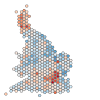Locally-varying explanations behind the United Kingdom's vote to leave the European Union
Keywords:
European Union, referendum, multi-level modelling, geographically-weighted statistics, LASSO, area-based analysisAbstract
Explanations behind area-based (Local Authority-level) voting preference in the 2016 referendum on membership of the European Union are explored using aggregate-level data. Developing local models, special attention is paid to whether variables explain the vote equally well across the country. Variables describing the post-industrial and economic "successfulness" of Local Authorities most strongly discriminate variation in the vote. To a lesser extent this is the case for variables linked to "metropolitan" and "big city" contexts, which assist the Remain vote, those that distinguish more traditional and "nativist" values, assisting Leave, and those loosely describing material outcomes, again reinforcing Leave. Whilst variables describing economic competitiveness co-vary with voting preference equally well across the country, the importance of secondary variables - those distinguishing metropolitan settings, values and outcomes - does vary by region. For certain variables and in certain areas, the direction of effect on voting preference reverses. For example, whilst levels of European Union migration mostly assist the Remain vote, in parts of the country the opposite effect is observed.

Downloads
Published
Issue
Section
License
Copyright (c) 2018 Roger Beecham, Aidan Slingsby, Chris Brunsdon

This work is licensed under a Creative Commons Attribution 4.0 International License.
Articles in JOSIS are licensed under a Creative Commons Attribution 3.0 License.
